The global Railway Communication Equipment market is projected to grow from USD 682.1 million in 2025 to approximately USD 1,059.3 million by 2035, recording an absolute increase of USD 377.2 million over the forecast period. This translates into a total growth of 55.3%, with the market forecast to expand at a compound annual growth rate (CAGR) of 4.5% between 2025 and 2035. The overall market size is expected to grow by approximately 1.6X during the same period, supported by accelerating demand for advanced communication systems in high-speed railway networks, expanding freight rail operations requiring robust communication infrastructure, and increasing adoption of next-generation railway signaling technologies across global transportation networks.
The steady market expansion reflects the critical importance of reliable communication equipment in modern railway operations and safety systems. Major infrastructure modernization projects worldwide are increasingly incorporating advanced GSM-R and FRMCS communication systems to enhance operational efficiency and ensure passenger safety, while breakthrough developments in railway digitalization are creating substantial demand for integrated communication platforms. The transportation sector is experiencing significant transformation as railway operators implement intelligent communication systems that support real-time train control, predictive maintenance programs, and comprehensive passenger information services.
Manufacturing capabilities are advancing rapidly as leading producers invest in next-generation communication technologies and specialized production facilities to meet growing demand from railway operators. The technology landscape continues evolving with innovations in radio frequency management, digital signal processing, and network architecture that enhance communication reliability while reducing system complexity and operational costs. Railway equipment manufacturers and communication technology providers are collaborating extensively to develop integrated communication solutions that address specific operational requirements across high-speed passenger rail, freight transportation, and urban transit systems.
Quality standards are becoming increasingly stringent as railway applications demand higher performance specifications and greater reliability under extreme operating conditions and diverse environmental challenges. Industry certification programs and testing protocols ensure consistent product quality while supporting market confidence in advanced communication technology adoption across critical transportation infrastructure and safety-critical applications.
International collaboration is accelerating market development as major railway projects require coordinated communication standards between multiple countries and transportation authorities. The European Train Control System represents a significant standardization effort, creating unified specifications for railway communication performance that influence global manufacturing standards and interoperability requirements. Private railway operators and national transportation authorities are establishing strategic partnerships with communication equipment manufacturers to secure long-term supply agreements and co-develop next-generation railway communication solutions tailored to specific operational and regulatory requirements.
Investment patterns are shifting toward integrated communication platforms as railway operators seek to consolidate multiple communication functions into unified systems that reduce complexity and operational costs. Transportation authorities are forming joint ventures with equipment manufacturers to develop customized solutions for specific railway applications, while high-speed rail operators are acquiring advanced communication capabilities to guarantee system reliability for their passenger service programs. This trend toward comprehensive communication integration and strategic partnerships is reshaping competitive dynamics across the railway communication equipment value chain.
Market maturation is evident in the emergence of specialized application segments that demand unique communication characteristics and performance specifications. High-speed railway applications require extremely reliable communication systems under high-velocity conditions and electromagnetic interference, while freight rail operations need communication solutions that maintain performance reliability across extended distances and diverse geographical conditions. These specialized requirements are driving innovation in antenna design, signal processing algorithms, and network architecture that extend beyond traditional railway communication applications.
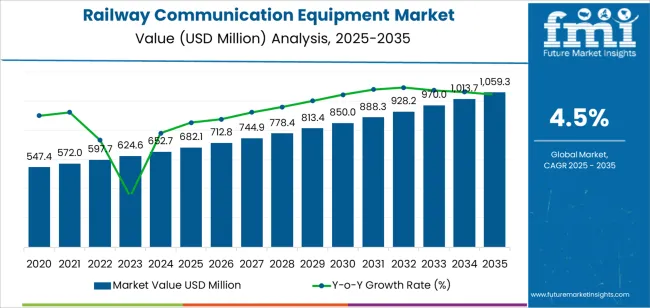
| Metric | Value |
|---|---|
| Market Value (2025) | USD 682.1 million |
| Market Forecast Value (2035) | USD 1,059.3 million |
| Forecast CAGR (2025-2035) | 4.5% |
| HIGH-SPEED RAILWAY EXPANSION | FREIGHT RAIL MODERNIZATION | SAFETY SYSTEM ADVANCEMENT |
|---|---|---|
| Railway Network Development -- Global high-speed railway programs including China's HSR expansion and European high-speed corridors driving unprecedented demand for advanced communication systems supporting train control, passenger information, and operational coordination. | Freight Infrastructure Upgrade -- Railway operators investing in modern communication equipment and digital signaling systems to enhance cargo tracking, improve operational efficiency, and reduce transportation delays across freight networks. | Safety Technology Enhancement -- Advanced railway safety systems and collision avoidance technology requiring high-performance communication solutions for real-time train monitoring and emergency response capabilities. |
| International Connectivity -- Cross-border railway projects and international high-speed connections requiring standardized communication protocols and interoperable equipment supporting seamless operations across multiple railway networks and regulatory frameworks. | Logistics Integration -- Container shipping and intermodal transportation requiring integrated communication systems and real-time tracking capabilities utilizing advanced railway communication technology for supply chain optimization. | Regulatory Compliance -- Modern railway safety regulations and international standards requiring precision communication components and comprehensive monitoring systems utilizing high-performance railway communication solutions. |
| Urban Transit Expansion -- Metropolitan railway systems and suburban commuter networks upgrading communication infrastructure with next-generation equipment and advanced passenger information systems supporting growing urban transportation demand. | Automated Operations -- Smart freight operations incorporating autonomous train control and predictive maintenance systems that require reliable communication infrastructure and advanced data transmission capabilities. | Emergency Response -- Enhanced emergency communication systems and disaster response capabilities requiring robust communication equipment with superior reliability and operational performance across diverse conditions. |
| Category | Segments / Values |
|---|---|
| By Type | Radio Equipment; GSM-R Equipment; FRMCS Equipment; Others |
| By Application | High-speed Railway; Ordinary Freight Railway; Ordinary Passenger Railway; Others |
| By End-User | Railway Operators; Transportation Authorities; Infrastructure Providers; Maintenance Services; Others |
| By Distribution Channel | Direct Sales; Authorized Distributors; System Integrators; OEM Partners |
| By Region | North America; Europe; Asia Pacific; Latin America; Middle East & Africa |
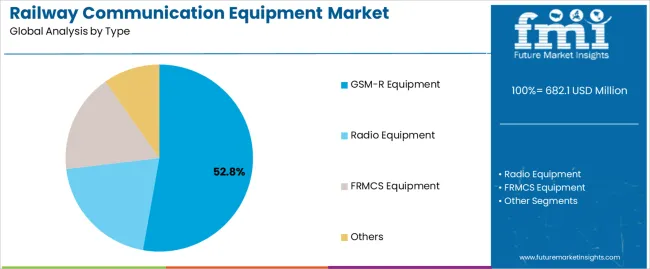
| Segment | 2025-2035 Outlook |
|---|---|
| GSM-R Equipment | Leader in 2025 with 52.8% market share; established standard for railway communication across European networks and expanding globally. Widely adopted for train control systems and operational communication. Momentum: steady growth across established railway markets. Watchouts: transition to FRMCS technology in long-term planning. |
| Radio Equipment | Significant segment with 28.7% share, essential for basic communication needs and legacy railway systems requiring reliable voice communication. Momentum: stable demand in developing railway markets. Watchouts: technology obsolescence and limited data capabilities. |
| FRMCS Equipment | Emerging segment representing next-generation railway communication technology offering enhanced data capabilities and improved spectrum efficiency. Momentum: strong growth as railways plan technology transitions. Watchouts: high implementation costs and technical complexity. |
| Others | Includes specialized communication equipment and custom solutions for unique railway applications. Momentum: niche growth in specific operational requirements. |
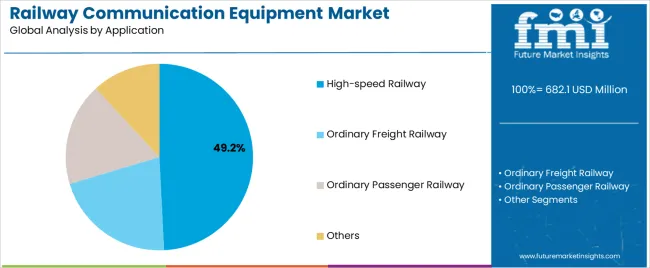
| Segment | 2025-2035 Outlook |
|---|---|
| High-speed Railway | Largest application segment in 2025 at 49.2% share, driven by global high-speed rail expansion and advanced communication requirements for safety and operational efficiency. Momentum: robust growth from continued HSR development worldwide. Watchouts: high technical specifications and regulatory compliance requirements. |
| Ordinary Freight Railway | Critical segment representing 31.6% share, experiencing steady growth from freight rail modernization and logistics automation programs. Momentum: consistent growth driven by cargo transportation demand. Watchouts: cost sensitivity and extended replacement cycles. |
| Ordinary Passenger Railway | Established segment at 15.4% share for conventional passenger rail services requiring reliable communication systems for safety and passenger information. Momentum: moderate growth from service improvements. Watchouts: budget constraints and competing transportation modes. |
| Others | Includes urban transit, industrial railways, and specialized applications. Momentum: diverse opportunities across various railway segments. |
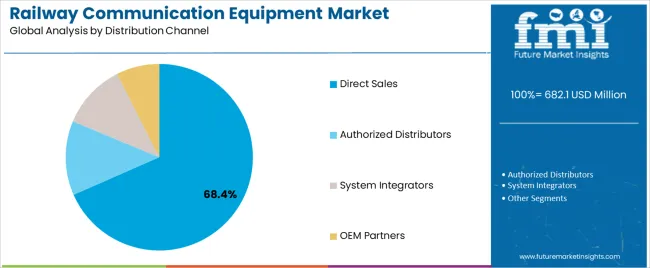
| Distribution Channel | Status & Outlook (2025-2035) |
|---|---|
| Direct Sales | Dominant channel in 2025 with 68.4% share for complex railway communication projects. Provides technical consultation, system integration, and customized solutions for major railway operators. Momentum: strong growth driven by large-scale infrastructure projects requiring direct manufacturer engagement. Watchouts: resource constraints and technical support capacity limitations. |
| Authorized Distributors | Technical distribution serving regional railway operators and maintenance providers with comprehensive product knowledge and local market expertise. Momentum: moderate growth as market expands geographically. Watchouts: limited technical expertise for complex systems. |
| System Integrators | Specialized channel for comprehensive railway communication solutions combining multiple technologies and vendors into unified systems. Momentum: growing importance as railways seek integrated solutions. |
| OEM Partners | Strategic partnerships with rolling stock manufacturers and railway equipment suppliers integrating communication systems into complete railway solutions. Momentum: significant growth as equipment integration increases. |
| DRIVERS | RESTRAINTS | KEY TRENDS |
|---|---|---|
| High-Speed Rail Expansion across major economies including China, Europe, and emerging markets creating unprecedented demand for advanced communication systems supporting train control and passenger services. | High Implementation Costs and complex integration requirements limit adoption across smaller railway operators and developing railway markets with budget constraints. | Technology Transition -- Migration from GSM-R to FRMCS technology driving investment in next-generation communication infrastructure with enhanced capabilities and spectrum efficiency. |
| Railway Safety Regulations -- Enhanced safety standards and collision avoidance requirements driving adoption of advanced communication systems and real-time monitoring capabilities across global railway networks. | Technical Complexity -- System integration challenges, interoperability requirements, and specialized expertise affect deployment timelines and operational capabilities across diverse railway environments. | Digital Integration -- Integration with digital railway systems, IoT platforms, and predictive maintenance technologies creating comprehensive communication solutions for modern railway operations. |
| Freight Rail Modernization -- Global supply chain optimization and cargo tracking requirements driving investment in communication systems supporting automated operations and real-time logistics management. | Regulatory Variations -- Different national standards, approval processes, and technical specifications create barriers for equipment standardization and international market expansion. | Network Convergence -- Convergence of voice, data, and video communication into unified platforms reducing system complexity and operational costs for railway operators. |
| Urban Transportation Growth -- Metropolitan railway expansion and suburban commuter network development supporting demand for passenger information systems and operational communication equipment. | Long Replacement Cycles -- Extended equipment lifecycles and conservative upgrade approaches in railway industry limit market growth and technology adoption rates across established networks. | Spectrum Optimization -- Advanced spectrum management and frequency coordination improving communication efficiency and supporting multiple railway operators in shared corridors. |
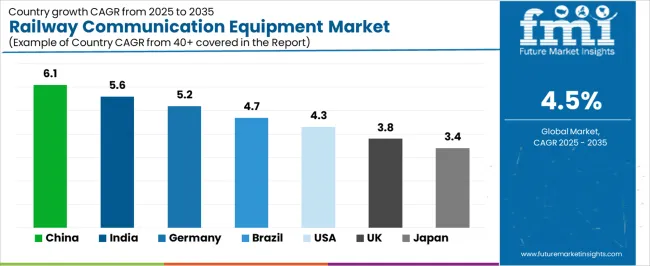
| Country | CAGR (2025-2035) |
|---|---|
| China | 6.1% |
| India | 5.6% |
| Germany | 5.2% |
| Brazil | 4.7% |
| United States | 4.3% |
| United Kingdom | 3.8% |
| Japan | 3.4% |
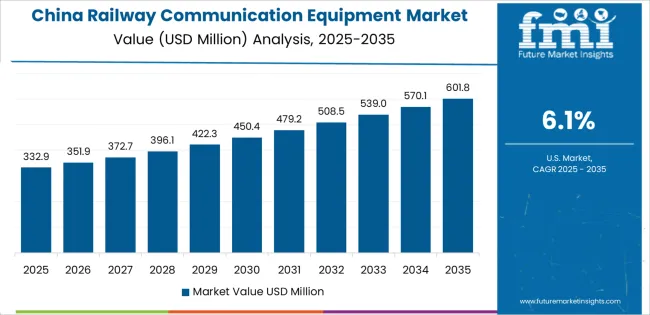
Revenue from Railway Communication Equipment in China is projected to exhibit exceptional growth with a market value of USD 238.4 million by 2035, driven by massive high-speed railway expansion programs and comprehensive freight rail modernization initiatives creating substantial opportunities for communication equipment suppliers across passenger transportation, cargo logistics, and urban transit sectors. The country's ambitious high-speed rail development programs including extensive HSR network expansion and cross-border connectivity projects are creating unprecedented demand for advanced communication systems. Major state-owned railway operators and infrastructure developers including China Railway Corporation and CRRC are establishing comprehensive communication technology deployment programs to support large-scale passenger and freight operations.
Revenue from Railway Communication Equipment in India is expanding to reach USD 129.8 million by 2035, supported by extensive railway modernization programs and comprehensive infrastructure development creating demand for communication solutions across diverse passenger services and freight transportation segments. The country's growing high-speed rail capabilities and expanding conventional railway network are driving demand for equipment solutions that provide exceptional reliability while supporting advanced operational requirements. Railway operators and infrastructure developers are investing in communication technology upgrades to support growing passenger traffic and freight logistics demand.
Demand for Railway Communication Equipment in Germany is projected to reach USD 135.2 million by 2035, supported by the country's leadership in railway technology and advanced communication systems requiring sophisticated equipment for high-speed passenger services and freight transportation applications. German railway operators are implementing cutting-edge communication programs that support advanced operational capabilities, safety protocols, and comprehensive performance standards. The market is characterized by focus on technical innovation, system reliability, and compliance with stringent European railway safety and interoperability standards.
Revenue from Railway Communication Equipment in Brazil is growing to reach USD 97.7 million by 2035, driven by railway infrastructure development programs and increasing freight transportation capabilities creating opportunities for communication equipment suppliers serving both passenger operations and specialized cargo logistics contractors. The country's expanding railway network and growing industrial transportation requirements are creating demand for communication components that support diverse operational requirements while maintaining performance standards. Railway operators and logistics companies are developing technology strategies to support operational efficiency and safety advancement.
Demand for Railway Communication Equipment in United States is projected to reach USD 155.4 million by 2035, expanding at a CAGR of 4.3%, driven by freight rail excellence and specialized passenger applications supporting regional transportation development and comprehensive cargo logistics applications. The country's established freight railway tradition and emerging passenger rail initiatives are creating demand for reliable communication components that support operational advancement and safety standards. Railway operators and equipment suppliers are maintaining comprehensive development capabilities to support diverse freight and passenger requirements.
Revenue from Railway Communication Equipment in United Kingdom is growing to reach USD 152.5 million by 2035, supported by railway network integration and established transportation systems driving demand for advanced communication solutions across traditional passenger services and specialized freight applications. The country's comprehensive railway network and established operational heritage create demand for communication equipment that supports both legacy system enhancement and modern operational applications.
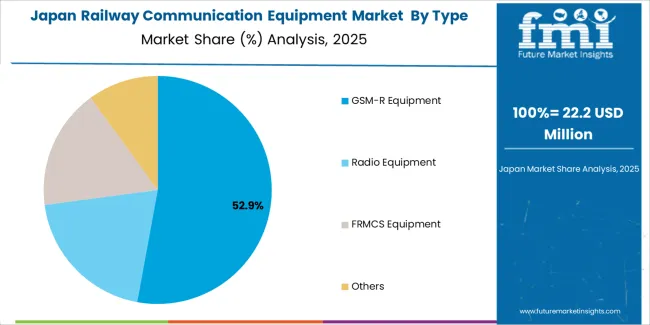
Demand for Railway Communication Equipment in Japan is projected to reach USD 124.6 million by 2035, driven by railway technology tradition and established operational leadership supporting both domestic transportation markets and export-oriented technology development. Japanese railway operators maintain sophisticated communication system capabilities, with established companies continuing to lead in high-speed rail technology and precision operational standards.
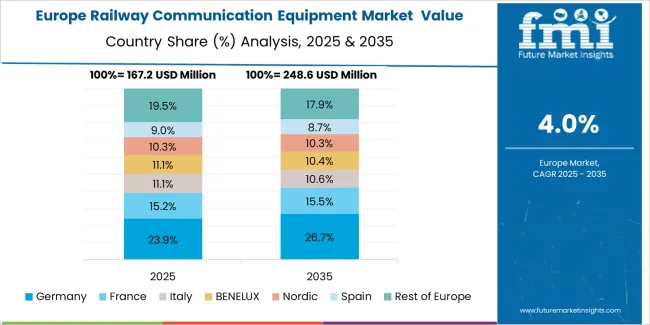
European Railway Communication Equipment operations are increasingly concentrated between German technology excellence and specialized communication system manufacturing across multiple countries. German facilities dominate advanced communication equipment production for high-speed railway and freight applications, leveraging cutting-edge technology development and strict quality protocols that command price premiums in global markets. British railway operators maintain leadership in network integration and cross-border connectivity, with organizations like Network Rail driving technical specifications that suppliers must meet to access major infrastructure contracts.
Eastern European operations in Czech Republic and Poland are capturing specialized manufacturing contracts through advanced engineering expertise and EU compliance standards, particularly in GSM-R system integration and FRMCS technology development for international railway applications. These facilities increasingly serve as development partners for Western European railway programs while building their own communication technology expertise.
The regulatory environment presents both opportunities and constraints. European railway framework requirements create quality standards that favor established European manufacturers and railway operators while ensuring consistent performance specifications for critical transportation and safety applications. Brexit has created complexity for UK railway integration with EU transportation programs, driving opportunities for direct relationships between British operators and international communication equipment suppliers.
Technology standardization accelerates as operators seek interoperability advancement to support major cross-border transportation initiatives and commercial development timelines. Vertical integration increases, with major railway organizations acquiring specialized communication capabilities to secure equipment supplies and quality control for critical operational programs. Smaller railway operators face pressure to adopt standardized solutions or risk operational incompatibility with larger, more comprehensive networks serving mainstream transportation requirements.
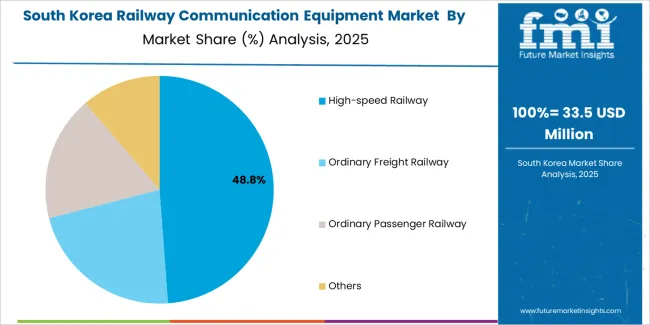
South Korean Railway Communication Equipment operations reflect the country's advanced high-speed railway capabilities and technology development model. Major railway operators including KORAIL drive communication equipment procurement strategies for their KTX high-speed network, establishing direct relationships with specialized communication system suppliers to secure consistent quality and performance for their passenger services and advanced operational control systems targeting both domestic transportation and international technology export projects.
The Korean market demonstrates particular strength in integrating communication equipment into high-speed railway systems and advanced train control configurations, with railway operators developing solutions that bridge traditional communication applications and next-generation transportation management systems. This integration approach creates demand for specific performance specifications that differ from conventional applications, requiring suppliers to adapt communication capabilities and system reliability characteristics.
Regulatory frameworks emphasize transportation safety and operational reliability, with Korean railway safety standards often exceeding international requirements for communication system performance. This creates barriers for standard equipment suppliers but benefits established manufacturers who can demonstrate railway-grade performance capabilities. The regulatory environment particularly favors suppliers with KTX qualification and comprehensive testing documentation systems.
Supply chain excellence remains critical given Korea's high-speed railway leadership focus and international collaboration dynamics. Railway operators increasingly pursue development partnerships with suppliers in Japan, Germany, and specialized manufacturers to ensure access to cutting-edge communication technologies while managing operational risks. Investment in transportation infrastructure supports performance advancement during extended railway development cycles.
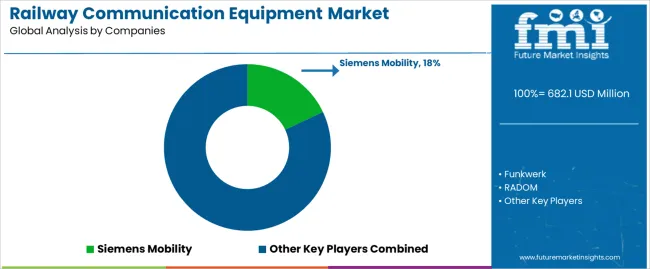
Profit pools are consolidating upstream in advanced communication system manufacturing and downstream in application-specific solutions for high-speed railway, freight operations, and passenger transportation markets where certification, signal reliability, and exceptional communication performance command substantial premiums. Value is migrating from basic communication equipment production to specification-driven, application-ready railway solutions where system engineering expertise, integration capabilities, and reliable performance under operational conditions create competitive advantages.
Several archetypes define market leadership: established European manufacturers defending share through advanced GSM-R technology and railway expertise; American communication companies leveraging comprehensive freight rail connections and system integration capabilities; Asian technology leaders with high-speed railway intellectual property and advanced manufacturing expertise; and emerging manufacturers pursuing cost-effective production while developing railway-specific communication capabilities.
Switching costs - system integration, railway certification, performance validation - provide stability for established suppliers, while technology transition requirements and railway modernization create opportunities for innovative manufacturers. Consolidation continues as companies seek manufacturing scale; direct railway partnerships grow for specialized applications while traditional distribution remains relationship-driven. Focus areas: secure high-speed railway and freight transportation market positions with application-specific performance specifications and technical collaboration; develop next-generation communication technology and advanced system integration capabilities; explore specialized applications including urban transit and cross-border railway requirements.
| Stakeholder Type | Primary Advantage | Repeatable Plays |
|---|---|---|
| European Railway Leaders | GSM-R expertise; proven railway heritage; established operator relationships | Precision engineering; technical innovation; safety compliance |
| American Communication Companies | Strong freight rail connections; comprehensive system capabilities; established customer partnerships | System integration focus; operational solutions; technical consultation |
| Asian Technology Manufacturers | High-speed railway expertise; advanced manufacturing; competitive cost structures | Technology leadership; production efficiency; performance optimization |
| Emerging Technology Providers | Manufacturing efficiency; competitive pricing; rapid development capabilities | Production scaling; technology advancement; market entry strategies |
| Specialized Distributors | Technical distribution networks; railway operator relationships | Railway expertise; inventory management; technical support services |
| Item | Value |
|---|---|
| Quantitative Units | USD 682.1 million |
| Type Segments | Radio Equipment; GSM-R Equipment; FRMCS Equipment; Others |
| Applications | High-speed Railway; Ordinary Freight Railway; Ordinary Passenger Railway; Others |
| End-Users | Railway Operators; Transportation Authorities; Infrastructure Providers; Maintenance Services; Others |
| Distribution Channels | Direct Sales; Authorized Distributors; System Integrators; OEM Partners |
| Regions Covered | North America; Latin America; Europe; Asia Pacific; Middle East & Africa |
| Key Countries | China; India; Germany; Brazil; United States; United Kingdom; Japan (+35 additional countries) |
| Key Companies Profiled | Siemens Mobility; Funkwerk; RADOM; Leonardo; Ritron; T-CZ; JEM Communications; Kontron Transportation; Hitachi Energy; Bohr Electronics; Beijing Gentury EAST Zhihui Technology; Beijing Jinhong Xi-Dian Information Technology |
| Additional Attributes | Dollar sales by type and application; Regional demand trends (NA, EU, APAC); Competitive landscape; Direct vs. distributor adoption patterns; Manufacturing and technology integration; Advanced communication innovations driving signal reliability, operational efficiency, and railway safety excellence |
By Type
The global railway communication equipment market is estimated to be valued at USD 682.1 million in 2025.
The market size for the railway communication equipment market is projected to reach USD 1,059.3 million by 2035.
The railway communication equipment market is expected to grow at a 4.5% CAGR between 2025 and 2035.
The key product types in railway communication equipment market are gsm-r equipment, radio equipment, frmcs equipment and others.
In terms of application, high-speed railway segment to command 49.2% share in the railway communication equipment market in 2025.






Full Research Suite comprises of:
Market outlook & trends analysis
Interviews & case studies
Strategic recommendations
Vendor profiles & capabilities analysis
5-year forecasts
8 regions and 60+ country-level data splits
Market segment data splits
12 months of continuous data updates
DELIVERED AS:
PDF EXCEL ONLINE
Railway Rolling Stock Market Forecast and Outlook 2025 to 2035
Railway System Market Size and Share Forecast Outlook 2025 to 2035
Railway Air Conditioning System Market Size and Share Forecast Outlook 2025 to 2035
Railway Braking System Market Size and Share Forecast Outlook 2025 to 2035
Railway CNC Wheel Lathe Market Size and Share Forecast Outlook 2025 to 2035
Railway Flatcar Market Size and Share Forecast Outlook 2025 to 2035
Railway Roof Switches Market Size and Share Forecast Outlook 2025 to 2035
Railway Window Market Size and Share Forecast Outlook 2025 to 2035
Railway Maintenance Machinery Market Size and Share Forecast Outlook 2025 to 2035
Railway Control Stands Market Size and Share Forecast Outlook 2025 to 2035
Railway Horn Market Size and Share Forecast Outlook 2025 to 2035
Railway Axlebox Housing Market Analysis - Size, Share, and Forecast Outlook 2025 to 2035
Railway After-Cooler Market - Growth & Demand 2025 to 2035
Railway Fishplate Market Growth – Trends & Forecast 2025 to 2035
Railway Coupler Market Growth & Demand 2025 to 2035
Railway Generators Market Growth - Trends & Forecast 2025 to 2035
Railway Draft Gears Market Growth – Trends & Forecast 2025 to 2035
Railway Emergency Valves Market Trends and Forecast 2025 to 2035
Railway Air Filter Market – Growth & Demand 2025 to 2035
Railway Traction Motor Market Growth – Trends & Forecast 2025 to 2035

Thank you!
You will receive an email from our Business Development Manager. Please be sure to check your SPAM/JUNK folder too.
Chat With
MaRIA